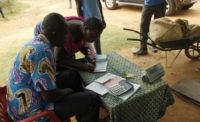The International Cocoa Initiative (ICI) has nearly met its goal of reaching 200,000 children with child protection measures half-way through its six-year strategy.
Alongside releasing its 2017 annual report, the ICI said it has aided 188,000 children, though more vulnerable children and child laborers remain unassisted in West African cocoa-growing areas, a situation the ICI says calls for innovation, adaptation and capacity-building to bring good practices adopted by ICI, its members and its partners to a larger scale.
By the end of 2017, ICI’s Child Labour Monitoring and Remediation System (CLMRS), implemented with six partnering companies, had targeted 127 cooperatives and 90,826 cocoa-farming households. This system had successfully identified 60 percent of child labor cases and has aided the ICI in removing more than half of the affected children from that environment.
ICI supports 75 cocoa-farming communities in Côte d’Ivoire and Ghana. More than 127,000 people — 63,886 children — have been helped through community development programs. New classroom facilities, vocational training courses and income-generating efforts for women all contributed to improved prospects for children. Nearly 4,000 children were enrolled into schools between 2016 and 2017 as a result of the ICI’s efforts.
“We are proud of our achievements but humbled by the task at hand,” says Nick Weatherill, ICI executive director. “Progress towards some of the targets set by ICI’s Strategy, and by CocoaAction, is significant, but as the recent Cocoa Barometer highlighted, we’ll still only have reached less than 20 percent of the estimated 2.1 million children working in unacceptable forms of child labour by 2020.”
Building on the data gathered over the last several years, the ICI plans to broaden its operations to help more children. Using the CLMRS, households with the most risk for child labor will be more selectively targeted. Other data indicate that a high education level among women correlates with reduced child labor risk in specific areas, suggesting that emphasis on improving girls’ education could be the most cost-effective way of reducing child labor over the long-term.
“If we test, prove and apply these theories not only to our own fieldwork but also to our dialogue and collaboration with other actors in the cocoa sector, including the national governments, we can expect to see even more progress over the coming years” Weatherill said.
World Day against Child Labor was observed Tuesday by organizations and governments worldwide. The ICI has launched its report strategically to highlight its own commitment to child protection efforts within the cocoa farming sector.



